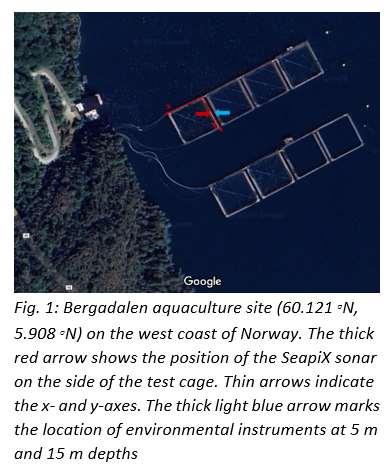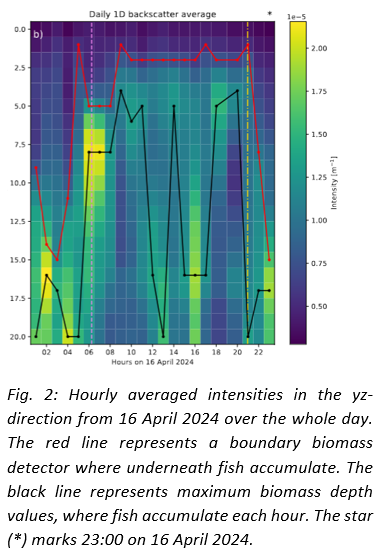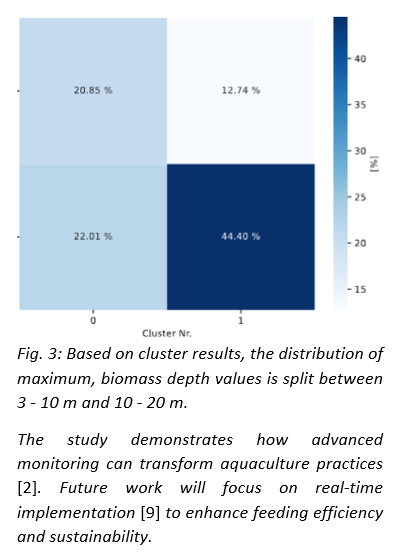UNDERSTANDING FISH BEHAVIOR FOR IMPROVED AQUACULTURE FEEDING MANAGEMENT
Feed inefficiency remains a critical challenge in global aquaculture, with Norway alone wasting up to 10\% of annual feed inputs [1].
Our study developed a comprehensive monitoring framework integrating 3D multibeam sonar technology [10] with environmental sensing to decode fish behavior patterns in sea cages near Bergen, Norway (Figure 1 ). The system captured continuous volumetric data while monitoring key environmental parameters including temperature, oxygen levels, and current velocity [8].
Our methodology employed Maximum Biomass Depth (MBD) calculations and Boundary Biomass (BB) detection [3] to track fish aggregations, enhanced through k-means clustering [7] . This revealed consistent diurnal patterns (Figure 2 ), with fish aggregating deeper (10-20 m) at night [12] and moving toward surface waters (3-10 m) during daylight. These patterns showed strong alignment with feeding times [6] , suggesting anticipatory behavior.
Vertical distribution analysis quantified behavioral states, showing fish spend 66.4% of low-activity periods at 10-20 m depths [11] while distributing more evenly during high-activity feeding periods. These findings enable data-driven feeding optimization [5] while improving fish welfare [4].
Acknowledgements
The work described has received funding from the Research Council of Norway under grant 341001. We are also grateful for the contribution of the industry partners, WAIVE, Aanderaa, and Lingalaks in making this project possible.
References
[1] Abualtaher, M., and Bar, E. S. Food-loss control at the macronutrient level: Protein inventory for the norwegian farmed salmon production system. Foods 9, 8 (2020), 1095.
[2] Cui, M., Liu, X., Liu, H., Zhao, J., Li, D., and Wang, W. Fish tracking, counting, and behaviour analysis in digital aquaculture: A comprehensive survey. Reviews in Aquaculture 17, 1 (2025), e13001.
[3] Demer , D. A., Berger, L., Bernasconi , M., Bethke, E., Boswell, K., Chu, D., Domokos, R., Dunford, A., Fassler , S., Gauthier , S., et al. Calibration of acoustic instruments.
[4] Fitzgerald, A., Ioannou, C. C., Consuegra, S., Dowsey, A., and Garcia de Leaniz, C. Machine vision applications for welfare monitoring in aquaculture: Challenges and opportunities. Aquaculture, Fish and Fisheries 5, 1 (2025), e70036.
[5] Fry, J. P., Love, D. C., MacDonald, G. K., West, P. C., Engstrom, P. M., Nachman, K. E., and Lawrence, R. S. Environmental health impacts of feeding crops to farmed fish. Environment international 91 (2016), 201–214.
[6] Georgopoulou, D. G., Vouidaskis, C., and Papandroulakis , N. Swimming behavior as a potential metric to detect satiation levels of european seabass in marine cages. Frontiers in Marine Science 11 (2024), 1350385.
[7] Hartigan, J. A., and Wong, M. A. Algorithm as 136: A k-means clustering algorithm. Journal of the royal statistical society. series c (applied statistics) 28, 1 (1979), 100–108.
[8] Johansson, D., Laursen, F., Ferno, A., Fosseidengen, J. E., Klebert , P., Stien, L. H., Vågseth, T., and Oppedal, F. The interaction between water currents and salmon swimming behaviour in sea cages. PloS one 9, 5 (2014), e97635.
[9] Måløy , H. Echobert: A transformer-based approach for behavior detection in echograms. IEEE Access 8 (2020), 218372–218385.
[10] Mosca, F., Matte, G., Lerda, O., Naud, F., Charlot, D., Rioblanc , M., and Corbieres, C. Scientific potential of a new 3d multibeam echosounder in fisheries and ecosystem research. Fisheries Research 178 (2016), 130–141.
[11] Oppedal, F., Vågseth , T., Dempster, T., Juell, J.-E., and Johansson, D. Fluctuating sea-cage environments modify the effects of stocking densities on production and welfare parameters of atlantic salmon (salmo salar l.). Aquaculture 315, 3-4 (2011), 361–368.
[12] Stehfest, K. M., Carter, C. G., McAllister, J. D., Ross, J. D., and Semmens, J. M. Response of atlantic salmon salmo salar to temperature and dissolved oxygen extremes established using animal-borne environmental sensors. Scientific reports 7, 1 (2017), 4545.




